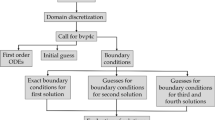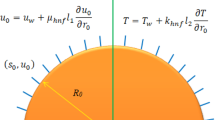Abstract
In this article, we are exploring the hemodynamics of nanofluid, flowing through a bifurcated artery with atherosclerosis in the presence of a catheter. For treating obstruction in the artery, one can use the catheter whose outer surface is carrying the drug coated with nano-particles. The resultant solvent is considered as blood nano-fluid. Blood being a complex fluid, is modeled by couple stress fluid. In the presence of nano-particles, the temperature and the concentration distribution are understood in a bifurcated stenotic artery. The concluded mathematical model is governed by coupled non-linear equations, and are solved by using the homotopy perturbation method. Consequently, we have explored is the effects of fluid and the embedded geometric parameters on the hemodynamics characteristics. It is also realized that high wall shear stress exists for couple stress nano-fluid when compared to Newtonian nanofluid. which is computed at a location corresponding to maximum constriction (z = 12.5) of the artery.
Similar content being viewed by others
References
World health statistics 2018: monitoring health for the sdgs, sustainable development goals, World Health Organization, et al, 2018.
A Arab, A Alfi. An adaptive gradient descent-based local search in memetic algorithm applied to optimal controller design, Inform Sciences, 2015, 299: 117–142.
D F Young, F Y Tsai. Flow characteristics in models of arterial stenoses — I. Steady flow, J Biomech, 1973, 6(4): 395–402.
D F Young, F Y Tsai. Flow characteristics in models of arterial stenoses — II. Unsteady flow, J Biomech, 1973, 6(5): 547–559.
T N D Ariman, M A Turk, N D Sylvester. Applications of microcontinuum fluid mechanics, Int J Eng Sci, 1974, 12(4): 273–293.
G Bugliarello, J Sevilla. Velocity distribution and other characteristics of steady and pulsatile blood flow in fine glass tubes, Biorheology, 1970, 7(2): 85–107.
V K Stokes. Couple stresses in fluids, Phys Fluids, 1966, 9(9): 1709–1715.
KB Chandran. Flow dynamics in the human aorta, J Biomech Eng, 1993, 115(4B): 611–616.
S Chakravarty, P K Mandal. An analysis of pulsatile flow in a model aortic bifurcation, Int J Eng Sci, 1997, 35(4): 409–422.
M C Truss, C G Stief, U Jonas. Werner forssmann: surgeon, urologist, and nobel prize winner, World J Urol, 1999, 17(3): 184–186.
A B M Hasan, D K Das. Numerical simulation of sinusoidal fluctuated pulsatile laminar flow through stenotic artery, J Appl Fluid Mech, 2008, 1(2): 25–35.
J V R Reddy, D Srikanth, SVSSNVG Krishna Murthy. Mathematical modelling of pulsatile flow of blood through catheterized unsymmetric stenosed artery-effects of tapering angle and slip velocity, Eur J Mech B Fluids, 2014, 48: 236–244.
D Srinivasacharya, G M Rao. Pulsatile flow of couple stress fluid through a bifurcated artery, Ain Shams Eng J, 2018, 9(4): 883–893.
A A Farooq, D Tripathi, T Elnaqeeb. On the propulsion of micropolar fluid inside a channel due to ciliary induced metachronal wave, Appl Math Comput, 2019, 347: 225–235.
T Elnaqeeb. Modeling of Au(NPs)-blood flow through a catheterized multiple stenosed artery under radial magnetic field, Eur Phys J Special Topics, 2019, 228: 2695–2712.
D Srinivasachary, G M Rao. Modeling of blood flow through a bifurcated artery using nanofluid, BioNanoScience, 2017, 7(3): 464–474.
Elnaqeeb, Thanaa, Nehad Ali Shah, Khaled S Mekheimer. Hemodynamic characteristics of gold nanoparticle blood flow through a tapered stenosed vessel with variable nanofluid viscosity, BioNanoScience, 2019, 9: 245–255.
Mekheimer, Khaled S, Mohamed S Mohamed, Thanaa Elnaqeeb. Metallic nanoparticles influence on blood flow through a stenotic artery, International Journal of Pure and Applied Mathematics, 2016, 107(1): 201.
Mekheimer, et al. Simultaneous effect of magnetic field and metallic nanoparticles on a micropolar fluid through an overlapping stenotic artery: Blood flow model, Physics Essays, 2016, 29(2): 272–283.
M Hatami, D D Ganji. Motion of a spherical particle in a fluid forced vortex by dqm and dtm, Particuology, 2014, 16: 206–212.
Wenhui Tang, M Hatami, Jiandong Zhou, Dengwei Jing. Natural convection heat transfer in a nanofluid-filled cavity with double sinusoidal wavy walls of various phase deviations, International Journal of Heat and Mass Transfer, 2017, 115: 430–440.
O Pourmehran, M Rahimi-Gorji, M Hatami, S A R Sahebi, G Domairry. Numerical optimization of microchannel heat sink (mchs) performance cooled by kkl based nanofluids in saturated porous medium, Journal of the Taiwan Institute of Chemical Engineers, 2015, 55: 49–68.
M Hatami. Nanoparticles migration around the heated cylinder during the rsm optimization of a wavy-wall enclosure, Advanced Powder Technology, 2017, 28(3): 890–899.
M Sheikholeslami, M Hatami, D D Ganji. Numerical investigation of nanofluid spraying on an inclined rotating disk for cooling process, Journal of Molecular Liquids, 2015, 211: 577–583.
Jiandong Zhou, M Hatami, Dongxing Song, Dengwei Jing. Design of microchannel heat sink with wavy channel and its time-efficient optimization with combined rsm and fvm methods, International Journal of Heat and Mass Transfer, 2016, 103: 715–724.
M Hatami, Dongxing Song, Dengwei Jing. Optimization of a circular-wavy cavity filled by nanofluid under the natural convection heat transfer condition, International Journal of Heat and Mass Transfer, 2016, 98: 758–767.
M Hatami, J Zhou, J Geng, D Song, D Jing. Optimization of a lid-driven t-shaped porous cavity to improve the nanofluids mixed convection heat transfer, Journal of Molecular Liquids, 2017, 231: 620–631.
G L Liu. New research directions in singular perturbation theory: artificial parameter approach and inverse-perturbation technique, In Conference of 7th modern mathematics and mechanics, 1997, 47–53.
Shi-Jun Liao. An approximate solution technique not depending on small parameters: a special example, International Journal of Non-Linear Mechanics, 1995, 30(3): 371–380.
Ji-Huan He. Variational iteration method for autonomous ordinary differential systems, Applied Mathematics and Computation, 2000, 114(2–3): 115–123.
Ji-Huan He. Homotopy perturbation technique, Computer methods in applied mechanics and engineering, 1999, 178(3–4): 257–262.
KM Surabhi, J V Ramana Reddy, D Srikanth. Impact of temperature and concentration dispersion on the physiology of blood nanofluid: links to atherosclerosis, Sadhana, 2018, 43(12): 210.
J V Ramana Reddy, D Srikanth, Samir K Das. Modelling and simulation of temperature and concentration dispersion in a couple stress nanofluid flow through stenotic tapered arteries, The European Physical Journal Plus, 2017, 132(8): 365.
Robin Fahraeus, Torsten Lindqvist. The viscosity of the blood in narrow capillary tubes, American Journal of Physiology-Legacy Content, 1931, 96(3): 562–568.
G K Batchelor. The effect of brownian motion on the bulk stress in a suspension of spherical particles, Journal of fluid mechanics, 1977, 83(1): 97–117.
M Hatami, J Hatami, Davood Domiri Ganji. Computer simulation of mhd blood conveying gold nanoparticles as a third grade non-newtonian nanofluid in a hollow porous vessel, Computer methods and programs in biomedicine, 2014, 113(2): 632–641.
Bock Choon Pak, Young I Cho. Hydrodynamic and heat transfer study of dispersed fluids with submicron metallic oxide particles, Experimental Heat Transfer an International Journal, 1998, 11(2): 151–170.
L Godson, B Raja, D Mohan Lal, S Wongwises. Experimental investigation on the thermal conductivity and viscosity of silver-deionized water nanofluid, Experimental Heat Transfer, 2010, 23(4): 317–332.
H C Brinkman. The viscosity of concentrated suspensions and solutions, The Journal of Chemical Physics, 1952, 20(4): 571–571.
R L Hamilton, O K Crosser. Thermal conductivity of heterogeneous two-component systems, Industrial & Engineering chemistry fundamentals, 1962, 1(3): 187–191.
Jacopo Buongiorno. Convective transport in nanofluids, Journal of heat transfer, 2006, 128(3): 240–250.
P Chaturani, D Biswas. A comparative study of poiseuille flow of a polar fluidunder various boundary conditions with applications to blood flow, Rheologica acta, 1984, 23(4): 435–445.
P Brunn. The velocity slip of polar fluids, Rheologica Acta, 1975, 14(12): 1039–1054.
Zi Fei Yin, Long Wu, Hua Gui Yang, Yong Hua Su. Recent progress in biomedicalapplications of titanium dioxide, Physical chemistry chemical physics, 2013, 15(14): 4844–4858.
Author information
Authors and Affiliations
Corresponding author
Additional information
Supported by Council of Scientific and Industrial Research (CSIR), INDIA (25(0262)/17/EMR-II).
Rights and permissions
About this article
Cite this article
Surabhi, K.M., Ravikanti, A., Srikanth, D. et al. Couple stress nanofluid flow through a bifurcated artery — Application of catheterization process. Appl. Math. J. Chin. Univ. 36, 492–511 (2021). https://doi.org/10.1007/s11766-021-3924-1
Received:
Revised:
Published:
Issue Date:
DOI: https://doi.org/10.1007/s11766-021-3924-1




